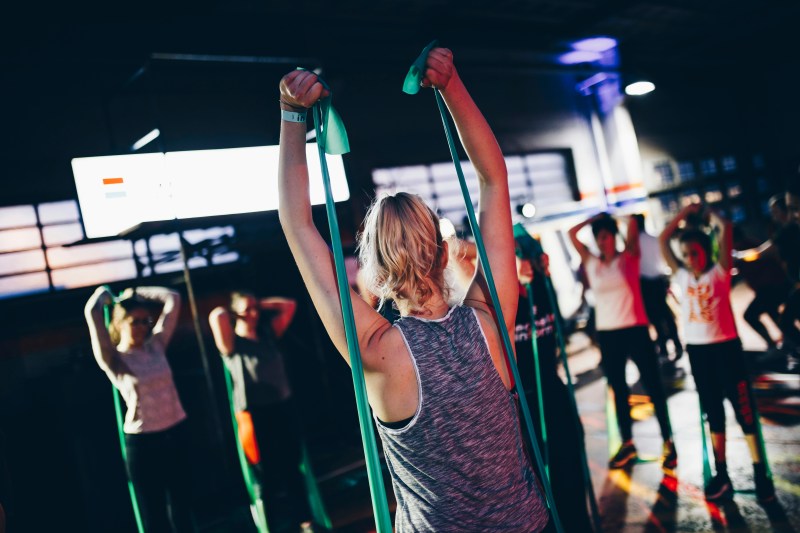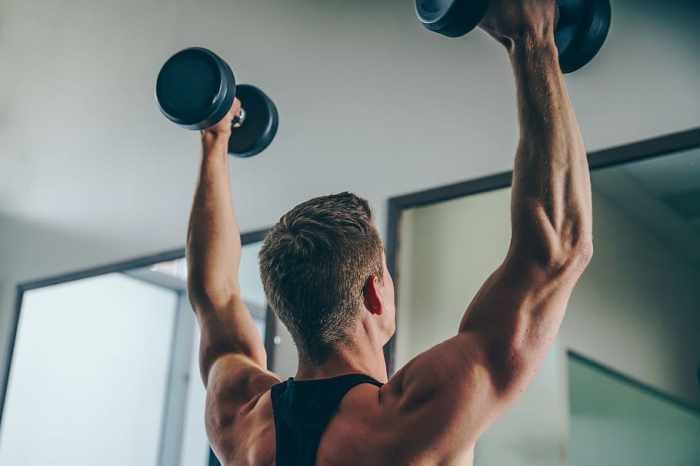
Fitness goals for 2025 sets the stage for this enthralling narrative, offering readers a glimpse into a story that is rich in detail and brimming with originality from the outset.
As we approach the new year, the importance of setting realistic and achievable fitness goals becomes paramount. It’s not just about the numbers or the aesthetics; it’s about creating a sustainable routine that enhances overall well-being. By breaking down these goals into manageable short-term and long-term targets, individuals can track their progress effectively, ensuring they stay motivated and accountable throughout their fitness journey.
Setting Fitness Goals for 2025
Setting realistic and achievable fitness goals is crucial for maintaining motivation and making progress. Whether you’re a beginner or a seasoned fitness enthusiast, having clear objectives can help you stay focused and accountable. By outlining specific targets, you can ensure that your fitness journey is both rewarding and manageable.Short-term fitness goals are those that can be accomplished within a few weeks to a couple of months, while long-term goals are typically set for a year or more.
Some examples of short-term goals could include running a 5K, increasing your squat weight, or committing to a consistent workout schedule. Long-term goals might involve training for a marathon, achieving a certain body composition, or improving overall health metrics such as cholesterol and blood pressure.Tracking progress is essential in reaching your fitness goals. Methods can include keeping a workout journal, using fitness apps to log workouts and meals, or employing wearable technology to monitor heart rate and activity levels.
Consistently reviewing your progress not only helps to keep you motivated but also allows you to adjust your goals as needed.
Home Health Care and Fitness
Home health care offers significant support for individuals striving to reach their fitness goals. Many people find it challenging to stay motivated and accountable when working out alone, and home health care can provide the necessary guidance and encouragement. With the right support, individuals can create a safe and effective workout environment tailored to their unique needs.A list of home exercises that can be done with minimal equipment includes:
- Bodyweight squats
- Push-ups
- Lunges
- Plank variations
- Resistance band exercises
- Jumping jacks
- Yoga and stretching routines
These exercises not only require little to no equipment but also can be easily modified to fit different fitness levels and goals.Home health care professionals play a vital role in fitness planning and support. They can help design personalized workout programs, monitor progress, and provide motivation. Additionally, they may offer nutritional guidance and education on safe exercise practices, reinforcing the importance of a holistic approach to health and fitness.
Health Blog Ideas for 2025
Creating a content calendar is an effective strategy for maintaining a consistent and engaging health blog focused on fitness and wellness topics. Popular ideas for blog posts in 2025 could include:
- Innovative home workout techniques
- The importance of mental health in fitness
- How to create a balanced meal plan
- Success stories from community fitness challenges
- Exploring new fitness trends and technologies
These topics can help draw readers in and encourage them to engage with your content.To engage an audience with fitness-related content, consider using relatable language, offering practical tips, and including personal anecdotes. Inviting guest posts from fitness professionals or sharing user-generated stories can prompt interaction and foster a sense of community. Social media plays a significant role in fitness motivation and community building, enabling individuals to share their progress, celebrate achievements, and inspire one another.
The Role of Healthcare Alliances in Fitness
Healthcare alliances provide numerous benefits for promoting fitness and wellness initiatives in communities. By collaborating with fitness professionals, these alliances can create comprehensive programs that address both physical health and preventative care. This collaboration can lead to increased awareness of fitness resources and improved access to health services.Collaboration opportunities between fitness professionals and healthcare providers could involve organizing community events, workshops, or fitness challenges.
Such initiatives can help foster a supportive environment that encourages individuals to adopt healthier lifestyles.Community programs supported by healthcare alliances often focus on inclusive fitness opportunities, ensuring that individuals of all ages and abilities can participate. These programs can range from free fitness classes in local parks to health fairs that provide access to screenings and consultations with health professionals.
By investing in community wellness, healthcare alliances promote a healthier, more active population.
Nutrition and Healthy Food Choices
A well-rounded fitness regimen is incomplete without proper nutrition. Below is a guide on healthy food options that support fitness goals:
- Lean proteins: chicken, turkey, tofu
- Whole grains: quinoa, brown rice, oats
- Fruits and vegetables: berries, leafy greens, sweet potatoes
- Healthy fats: avocados, nuts, olive oil
Incorporating these food groups into your diet can enhance performance and aid recovery.Meal prep ideas and recipes that align with fitness objectives include:
- Grilled chicken with roasted vegetables
- Quinoa salad with chickpeas and spinach
- Overnight oats with fruit and nuts
- Homemade smoothies with protein powder and greens
These meals are not only nutritious but also easy to prepare, making it simpler to stick to your fitness goals.Hydration plays a crucial role in achieving fitness objectives. Staying adequately hydrated can improve performance, aid muscle recovery, and enhance overall health. It’s essential to drink water throughout the day and consider electrolyte-rich beverages during intense workouts.
Health Equity in Fitness
Health equity is a significant concept that underscores the importance of fair access to fitness opportunities. This notion is particularly relevant as various communities face barriers when trying to access fitness resources, such as limited availability of gyms or safe spaces for physical activity.Barriers to accessing fitness resources can include:
- Economic constraints
- Lack of transportation
- Limited availability of fitness programs in certain areas
- Social stigma associated with fitness facilities
Addressing these barriers is crucial in creating a more equitable fitness landscape.Initiatives aimed at promoting fitness equity and inclusion often focus on community engagement and outreach. Programs that offer free or subsidized access to fitness facilities, provide transportation options, or develop culturally relevant fitness classes can help bridge the gap and ensure that all individuals have the opportunity to pursue their fitness goals.
Health Connector Role in Fitness
Health connectors play an essential role in facilitating access to fitness resources and support. These individuals help bridge the gap between the community and available health services, ensuring that individuals know their options and how to utilize them effectively.Strategies for using health connectors to identify personal fitness goals involve:
- Assessing current fitness levels and health status
- Discussing personal interests and preferences
- Setting realistic and achievable objectives
- Creating a personalized fitness plan
By leveraging the expertise of health connectors, individuals can enhance their fitness journey and remain accountable to their goals.Technology has a transformative impact on connecting individuals with fitness services. Mobile applications, telehealth consultations, and online fitness communities create opportunities for support, accountability, and motivation. These innovations can make fitness more accessible for everyone, regardless of their location.
Managing Health Anxiety in Fitness Pursuits
Health anxiety can be a significant barrier for many individuals while pursuing fitness goals. Managing this anxiety is critical to ensuring a positive and sustainable fitness experience. Practical techniques for managing health anxiety include:
- Practicing mindfulness and meditation
- Setting achievable goals and focusing on progress
- Engaging in open discussions about fears and concerns
- Seeking support from fitness communities or professionals
Addressing the psychological aspects of fitness and body image can lead to a healthier relationship with exercise.Mental health plays a vital role in achieving physical fitness. Recognizing that both mental and physical well-being are interconnected can help individuals adopt a more comprehensive approach to health. Developing coping strategies for stress and anxiety can enhance resilience and encourage long-term commitment to fitness.
Importance of Health and Safety in Fitness
Safety measures are paramount while exercising at home or in the gym to prevent injuries and ensure a positive experience. Some essential health and safety considerations include:
- Warming up before workouts
- Using proper form and technique
- Staying hydrated throughout exercise
- Listening to your body and resting as needed
Establishing a safe workout environment is crucial to achieving fitness goals.Health and safety jobs play a significant role in promoting fitness environments. These professionals are dedicated to ensuring that fitness facilities adhere to safety regulations and provide a secure atmosphere for individuals to work out. Their expertise helps foster a culture of safety within the fitness community.A checklist for safe exercise practices includes:
| Checklist Item | Status |
|---|---|
| Warm-up before exercising | ✔️ |
| Use appropriate footwear | ✔️ |
| Stay hydrated during workouts | ✔️ |
| Cool down after exercising | ✔️ |
Health Benefits of Regular Exercise
Regular exercise offers numerous physical and mental health benefits. Engaging in consistent physical activity can:
- Improve cardiovascular health
- Enhance strength and flexibility
- Boost mood and reduce symptoms of anxiety and depression
- Help prevent chronic diseases such as diabetes and obesity
These benefits contribute to an overall healthier lifestyle and improved quality of life.Exercise is also known to promote longevity. Studies have shown that individuals who engage in regular physical activity tend to live longer and healthier lives. Testimonials from individuals who have achieved significant health benefits through fitness often highlight increased energy levels, improved self-esteem, and a greater sense of community engagement.
The Role of Health Clinics in Fitness
Health clinics can provide essential support for fitness assessments and consultations. These facilities often have health professionals who can evaluate an individual’s fitness level and help create personalized fitness plans tailored to their needs.Services offered by health clinics that promote physical activity may include:
- Fitness assessments and screenings
- Nutritional counseling
- Group exercise classes
- Sports injury prevention and rehabilitation
Collaborating with local health clinics for fitness programs allows individuals to access valuable resources that enhance their fitness journey.
Health Care Assistants and Fitness Support

Health care assistants play a vital role in supporting fitness goals for clients. These professionals can help individuals navigate their fitness journeys by providing encouragement, accountability, and practical assistance with exercise routines.Training programs available for health care assistants focusing on fitness often include:
- Basic exercise physiology
- Nutritional education
- Client communication and motivation techniques
Equipping health care assistants with this knowledge ensures they can effectively support clients in their fitness pursuits.Collaborative approaches between fitness trainers and health care assistants can lead to a more comprehensive support system for clients. By working together, these professionals can develop individualized fitness plans that take into account medical histories, preferences, and specific fitness goals.
Health Diagnostics in Fitness Context
Health diagnostics are essential in creating personalized fitness plans. Assessing an individual’s medical history, fitness level, and specific health conditions can guide the development of a tailored exercise regimen.Common health assessments that may influence fitness goals include:
- Body composition analysis
- Cardiovascular fitness testing
- Flexibility measurements
- Strength evaluations
Understanding these metrics allows individuals to set realistic and achievable fitness goals.Advancements in health diagnostics technology are also impacting fitness. Wearable devices that monitor heart rate, activity levels, and sleep patterns provide valuable insights that can help individuals optimize their fitness routines and make informed lifestyle choices.
Health Essentials for Fitness
Having the right essentials is critical for maintaining a successful fitness regimen. Below is a list of items that can enhance your fitness experience:
- Comfortable workout clothing
- Quality athletic shoes
- Water bottle for hydration
- Yoga mat for stretching and floor exercises
- Resistance bands for strength training
Investing in quality gear can significantly impact workout performance and enjoyment.Proper maintenance and care of fitness equipment are also essential to ensure longevity and effectiveness. Regularly cleaning and inspecting equipment, following manufacturer guidelines, and storing items correctly will help keep everything in top shape.
Health Tips for Achieving Fitness Goals
Daily health tips can support ongoing fitness efforts significantly. Simple practices contribute to overall well-being and can help maintain motivation. Some key tips include:
- Prioritize sleep and recovery
- Stay consistent with workouts
- Track your nutrition and hydration
- Celebrate small victories
Establishing a routine that incorporates these tips will help build momentum towards achieving fitness goals.Sleep and recovery are vital components of any fitness regimen. Quality rest allows the body to repair and strengthen, ultimately enhancing performance. Incorporating rest days and active recovery sessions into your schedule maximizes results.Motivation strategies to maintain commitment to fitness goals can include setting up a reward system, finding a workout buddy, or participating in community challenges.
Engaging with others on a similar journey can foster accountability and provide encouragement.
Dental Care and Fitness
There is a notable connection between oral health and overall fitness. Maintaining good dental hygiene can contribute to better health outcomes, as poor oral health can lead to systemic issues that may affect fitness performance.Incorporating dental care into a fitness routine involves scheduling regular dental check-ups, practicing daily oral hygiene, and being mindful of diet choices that impact oral health.
This holistic approach ensures that individuals prioritize both fitness and dental health.A few tips for integrating dental care into a fitness lifestyle include:
- Brushing and flossing after meals, especially after workout snacks
- Avoiding sugary beverages that can harm teeth
- Using mouthguards during high-impact sports
By emphasizing both dental health and fitness, individuals can work towards achieving better overall health.
Healthcare Systems Supporting Fitness
Different healthcare systems play a crucial role in promoting fitness and wellness within communities. Many have implemented programs aimed at increasing awareness of fitness resources and opportunities available to residents.Policy initiatives aimed at improving community fitness opportunities often focus on expanding access to recreational facilities, funding fitness programs in schools, and promoting active transportation options. Collaborating with local governments and organizations can amplify these efforts.Success stories of healthcare systems that effectively integrate fitness into their services highlight the potential for positive community impact.
Examples may include community health fairs that provide free fitness assessments or initiatives that partner with local gyms to offer discounted memberships for underserved populations.
Health and Medical Insurance Impacts on Fitness
Health insurance can significantly influence access to fitness programs and resources. Many plans offer coverage for gym memberships, fitness classes, or wellness programs, encouraging individuals to prioritize their health.Benefits of insurance-covered fitness resources can include reduced costs for regular access to workout facilities, health assessments, and fitness classes. Engaging with insurance providers about available fitness benefits can empower individuals to maximize their health plans.Strategies for advocating for fitness benefits within health insurance plans may involve collaborating with healthcare professionals to demonstrate the value of physical activity in preventing chronic diseases, thereby justifying coverage for fitness services.
Health and Medical Sciences in Fitness Research

Ongoing research in health and medical sciences is continuously shaping fitness trends. Recent studies have highlighted the efficacy of various exercise modalities, leading to evidence-based recommendations for effective workout strategies.Findings from recent research related to exercise and health outcomes often underscore the importance of regular physical activity in disease prevention, overall health, and mental well-being. These insights can help inform the fitness goals of individuals and professionals alike.Innovative fitness solutions based on scientific research may include specialized workout programs designed to target specific health conditions or advanced training methods that enhance athletic performance.
Staying informed about the latest research can help individuals make educated choices regarding their fitness journeys.
Health and Medical Education for Fitness Professionals
Education and training for fitness professionals are vital in fostering knowledgeable and skilled individuals in the health and fitness industry. A strong educational foundation empowers trainers to provide safe and effective guidance to their clients.Key educational programs that focus on health and fitness often include certifications in personal training, nutrition, exercise science, and specialized training methods. Continuous education is crucial for staying current with industry trends and best practices.Career advancement opportunities in health and medical education related to fitness may involve specializing in areas such as sports performance, rehabilitation, or wellness coaching.
Pursuing further education can enhance professional prospects and improve the quality of service offered to clients.
Health and Beauty Shop Integration with Fitness
The relationship between health, beauty, and fitness industries is increasingly recognized as complementary. Many consumers are now seeking products that promote both physical health and aesthetic appeal, leading to a growing market for wellness-focused brands.Products that promote wellness and fitness available in health and beauty shops may include:
- Plant-based protein powders
- Hydrating skincare products
- Fitness apparel that combines functionality and style
- Supplements supporting energy and recovery
These items cater to health-conscious consumers looking to enhance their fitness routines.Marketing strategies for fitness professionals collaborating with beauty brands could focus on joint promotions, influencer partnerships, and educational content that connects fitness with beauty. Such collaborations can amplify brand visibility and tap into diverse consumer bases seeking holistic health solutions.
Final Review
In conclusion, establishing fitness goals for 2025 not only shapes your physical health but also fortifies your mental resilience. With the right support systems, including home health care, community programs, and proper nutrition, anyone can achieve their fitness aspirations. As we embark on this journey, let’s remember that every small step counts towards a healthier and more fulfilling life.
Popular Questions
What are realistic fitness goals for beginners?
Realistic fitness goals for beginners could include walking for 30 minutes a day, completing a certain number of workouts per week, or gradually increasing weight in strength training.
How can I stay motivated to achieve my fitness goals?
To stay motivated, set specific milestones, track your progress, find a workout buddy, and celebrate small achievements along the way.
What role does nutrition play in reaching fitness goals?
Nutrition is crucial for fueling your body, aiding recovery, and supporting overall health, making it a key component in successfully achieving fitness goals.
How often should I reassess my fitness goals?
It’s advisable to reassess your fitness goals every few months to ensure they remain relevant and challenging as you progress.
Can technology help me achieve my fitness goals?
Yes, various fitness apps and trackers can help monitor your progress, provide workout ideas, and keep you accountable.





